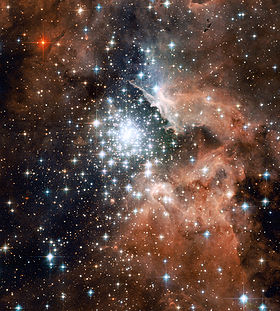Astronomy:MTT 68
| Observation data Epoch J2000.0 Equinox (celestial coordinates) | |
|---|---|
| Constellation | Carina |
| Right ascension | 11h 14m 59.500s[1] |
| Declination | −61° 14′ 33.89″[1] |
| Apparent magnitude (V) | 14.72[2] |
| Characteristics | |
| Spectral type | O2If*[2] |
| Apparent magnitude (K) | 8.74[2] |
| B−V color index | +1.59[2] |
| Astrometry | |
| Proper motion (μ) | RA: −8.601[1] mas/yr Dec.: +2.314[1] mas/yr |
| Parallax (π) | 0.4742 ± 0.6688[1] mas |
| Distance | 7,600[2] pc |
| Absolute magnitude (MV) | −6.4 (−6.1/−4.9)[2] |
| Details | |
| A | |
| Luminosity | 1,138,000[2] L☉ |
| B | |
| Luminosity | 377,000[2] L☉ |
| Age | 1[2] Myr |
| Other designations | |
2MASS J11145948-6114338, TIC 467481091, UCAC4 144-073052 | |
| Database references | |
| SIMBAD | data |
MTT 68 is a multiple star system located on the outskirts of the HD 97950 cluster in the NGC 3603 star-forming region, about 25,000 light years from Earth. It contains a rare example of an O2If* star which is one of the most luminous and most massive known.
MTT 68 was first identified as being associated with NGC 3603 when it was listed as object 68 in a survey of the region by Melnick, Tapia, and Terlevich published in 1989. It is 1.4′ from the centre of the main ionising cluster for NGC 3603.[3] In 2002, it was found to be a strong source of X-rays, indicating that it may be a close binary containing two massive stars. In 2013, it was classified with a spectral type of O2If*, only the second known example after the prototype HD 93129A, also in the constellation of Carina. The spectral class indicates that this is a very hot supergiant star with emission lines of triple-ionised nitrogen stronger than those of doubly-ionised nitrogen.[4]
MTT 68 is resolved into a pair of stars 0.38″ apart. The fainter component is 1.2 magnitudes dimmer than the brighter star. Although it is expected that MTT 68 is a binary due to its high x-ray luminosity, the observed companion is too distant to create the x-rays by colliding winds and a third, closer, companion is suspected.[2]
Although MTT 68 is catalogued in Gaia Data Release 3, the parallax is too imprecise to give a useful distance.[1] Analysis of the cluster as a whole allows a distance of 7.6 kpc to be calculated.[5] At that distance, interstellar extinction causes stars to be dimmed by about 6.7 magnitudes and strongly reddened. Correcting for this places both of the component stars near the main sequence within initial masses of at least 100 M☉ and 40 M☉ respectively.[2]
See also
References
- ↑ 1.0 1.1 1.2 1.3 1.4 1.5 Vallenari, A. et al. (2022). "Gaia Data Release 3. Summary of the content and survey properties". Astronomy & Astrophysics. doi:10.1051/0004-6361/202243940 Gaia DR3 record for this source at VizieR.
- ↑ 2.00 2.01 2.02 2.03 2.04 2.05 2.06 2.07 2.08 2.09 2.10 Roman-Lopes, A. (2013). "An O2If* star found in isolation in the backyard of NGC 3603". Monthly Notices of the Royal Astronomical Society 435. doi:10.1093/mnrasl/slt100. Bibcode: 2013MNRAS.435L..73R.
- ↑ Melnick, J.; Tapia, M.; Terlevich, R. (1989). "The galactic giant H II region NGC 3603". Astronomy and Astrophysics 213: 89. Bibcode: 1989A&A...213...89M.
- ↑ Roman-Lopes, A.; Franco, G. A. P.; Sanmartim, D. (2016). "SOAR Optical and Near-infrared Spectroscopic Survey of Newly Discovered Massive Stars in the Periphery of Galactic Massive Star Clusters I-NGC 3603". The Astrophysical Journal 823 (2): 96. doi:10.3847/0004-637X/823/2/96. Bibcode: 2016ApJ...823...96R.
- ↑ Huenemoerder, David P.; Schulz, Norbert S.; Nichols, Joy S. (2019). "Winds of Massive Stars: High-resolution X-Ray Spectra of Stars in NGC 3603". The Astronomical Journal 157 (1): 29. doi:10.3847/1538-3881/aaf380. Bibcode: 2019AJ....157...29H.
External links
- NASA Astronomy Picture of the Day: Starburst Cluster in NGC 3603 (5 October 2007)
- NASA Image of the day
 |


